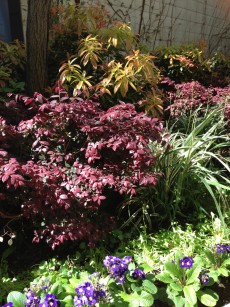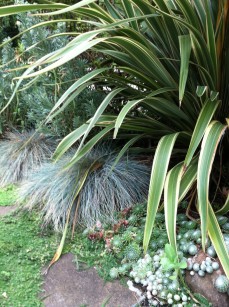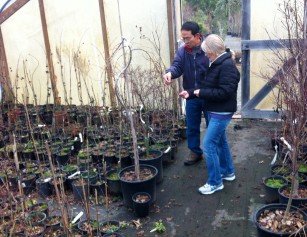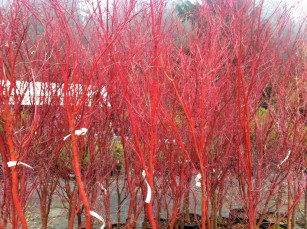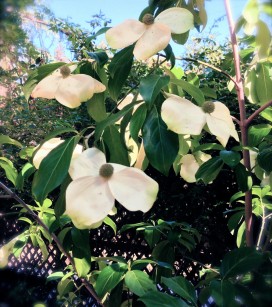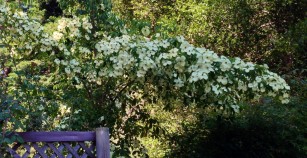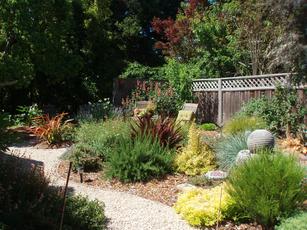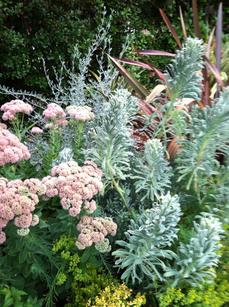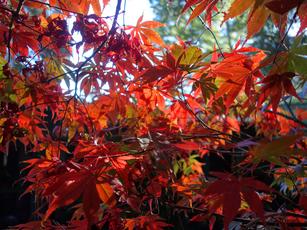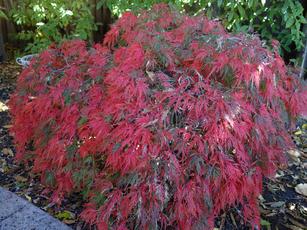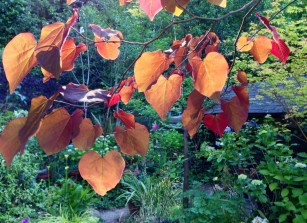 Outside my window, the Forest Pansy Redbud has started to display its spectacular burnt orange fall color. There?s a suet feeder hanging from the branches so I get to enjoy the antics of the Pygmy Nuthatches, Purple Finches and the Chestnut-backed Chickadees all day long as I watch the changing colors of the foliage. Out back I have a Catawba Crape Myrtle also starting to show fall color. Its leaves are turning a rich butterscotch shade which is lovely but not the reddish-orange described in the books. What causes fall color to vary from plant to plant? How does location in the garden, weather, climate and growing conditions affect what you see each fall?
Outside my window, the Forest Pansy Redbud has started to display its spectacular burnt orange fall color. There?s a suet feeder hanging from the branches so I get to enjoy the antics of the Pygmy Nuthatches, Purple Finches and the Chestnut-backed Chickadees all day long as I watch the changing colors of the foliage. Out back I have a Catawba Crape Myrtle also starting to show fall color. Its leaves are turning a rich butterscotch shade which is lovely but not the reddish-orange described in the books. What causes fall color to vary from plant to plant? How does location in the garden, weather, climate and growing conditions affect what you see each fall?
The brilliant fall color we see in the leaves of trees and plants is always there. It?s just masked by 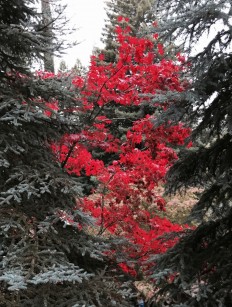 chlorophyll during the growing season as the plant is busy making food while the sun shines during photosynthesis. Come autumn, shorter days and cooler temperatures cause the trees to switch into energy-storage mode, at which point their leaves stop producing chlorophyll. For the few weeks before the leave fall to the ground, they are colored only by their natural pigments. It’s these colors – red and purple anthocyanins and yellow and orange carotenoids that make fall foliage so glorious.
chlorophyll during the growing season as the plant is busy making food while the sun shines during photosynthesis. Come autumn, shorter days and cooler temperatures cause the trees to switch into energy-storage mode, at which point their leaves stop producing chlorophyll. For the few weeks before the leave fall to the ground, they are colored only by their natural pigments. It’s these colors – red and purple anthocyanins and yellow and orange carotenoids that make fall foliage so glorious.
Some years the show is more dramatic than others. The best conditions for intense leaf color to develop are dry sunny days followed by cool, but not freezing nights. A warm, wet autumn will almost surely result in less-than-spectacular foliage because the process of chlorophyll loss will be less consistent. Freezing temperatures or winds meanwhile can cause leaves to drop suddenly denying them opportunity to enter their slow, colorful dormancy. Finally, trees that are under stress because of pests, disease, injury or drought may drop their leaves with no color change at all.
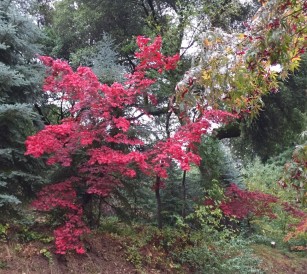 So if your garden becomes shady early in the fall this may result in less vivid fall foliage. If your trees are stressed by drought like this year you may not get the usual colorful fall display. These and the above factors all affect the intensity of fall foliage colors.
So if your garden becomes shady early in the fall this may result in less vivid fall foliage. If your trees are stressed by drought like this year you may not get the usual colorful fall display. These and the above factors all affect the intensity of fall foliage colors.
Now is a good time to shop for plants and trees that can punch up the color of fall in your garden. Seeing your new addition in person will show you exactly what color you are going to get. Sure Autumn Gold Ginkgo will probably always color up bright yellow and Sango Kaku Japanese maples will show off their characteristic golden foliage but the fall color of Purple Smoke Bush, Katsura tree, Witch Hazel, Pomegranate, Oakleaf Hydrangea and Blueberry, to name just a few, can vary.
First Frost
I received an email from someone new to the area about when to expect our first frost. I’ve kept a weather 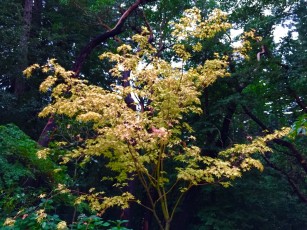 journal since 1992 and based on my records occasionally we get a light frost at the end of October. Mostly though, the earliest frost has occurred about second week of November with late November being the most common. Be prepared by moving frost tender plants under overhangs if possible or having frost blankets (not plastic) ready to cover delicate plants.
journal since 1992 and based on my records occasionally we get a light frost at the end of October. Mostly though, the earliest frost has occurred about second week of November with late November being the most common. Be prepared by moving frost tender plants under overhangs if possible or having frost blankets (not plastic) ready to cover delicate plants.
Transplanting in Fall
Need to move a plant or install plants out of containers and into the garden soil? Now through February offers the best time to do this. Soils are still warm at this time of year which helps new roots get established quicker than in later winter.
Prepare the new location first before excavating any plant. Dig a hole twice as wide as the rootball, but just the same depth. Use a sharp spade to make clean cuts through roots. Cut roots will form new, dense and healthy roots.
Before replanting, especially from a container, check for roots that have circled the interior of the pot. These must be tugged loose and straightened when planted. Don’t be shy about loosening roots. When replanting be certain to keep the rootball at the same level it was and don’t add soil over the rootball. Most plants need oxygen at the soil level.

